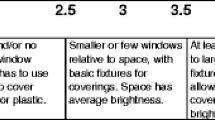Abstract
In this research, we examine the relationshipsbetween the housing characteristics and dimensions ofcommunity adaptation for 107 psychiatricconsumer/survivors. Hypotheses about which housingcharacteristics best predict which dimensions of adaptationwere made based on previous research and theory. Usinga longitudinal research design, we found, aftercontrolling for demographic variables and prioradaptation, that the number of living companions, housingconcerns, and having a private room all significantlypredicted different dimensions of community adaptation.The findings partially support our theoretical expectations and illuminate the relationshipbetween physical, social and organizational aspects ofcommunity-based housing and the adaptation ofpsychiatric consumer/survivors. We discuss theimplications of the results for policy and practice inproviding housing for this population.
Similar content being viewed by others
REFERENCES
Baker, F., & Douglas, C. (1990). Housing environments and community adjustment of severely mentally ill persons. Community Mental Health Journal, 26, 497–505.
Barker, R.G., & Gump, P.V. (1964). Big school, small school. Stanford: Stanford University Press.
Capponi, P. (1992). Upstairs in the cry house: The life of a psychiatric survivor. Toronto: Viking.
Diener, E., & Emmons, R.A. (1985). The independence of positive and negative affect. Journal of Personality and Social Psychology, 47, 1105–1117.
Earls, M., & Nelson, G. (1988). The relationship between long-term psychiatric clients’ psychological well-being and their perceptions of housing and social support. American Journal of Community Psychology, 16, 279–293.
Hall, G.B., & Nelson, G. (1996). Social networks, social support, personal empowerment and the adaptation of psychiatric consumer/survivors: Path analytic models. Social Science and Medicine, 43, 1743–1754.
Hellman, I.D., Greene, L.R., Morrison, T.L., & Abramowitz, S.I. (1985). Organizational size and perceptions in a residential treatment program. American Journal of Community Psychology, 13, 99–105.
Hogan, M.F., & Carling, P.J. (1992). Normal housing: A key element of a supported housing approach for people with psychiatric disabilities. Community Mental Health Journal, 28, 215–226.
Kruzich, J.M., & Berg, W. (1985). Predictors of self-sufficiency for the mentally ill in long-term care. Community Mental Health Journal, 21, 198–207.
McCarthy, J., & Nelson, G. (1991). An evaluation of supportive housing for current and former psychiatric patients. Hospital and Community Psychiatry, 42, 1254–1256.
McCarthy, J., & Nelson, G (1993). An evaluation of supportive housing: Qualitative and quantitative perspectives. Canadian Journal of Community Mental Health, 12(1), 157–175.
Moos, R.H., & Lemke, S. (1979). Multiphasic environmental assessment procedure (MEAP): Preliminary manual. Palo Alto, CA: Stanford University, Social Ecology Laboratory.
Nelson, G., Hall, G.B., Squire, D., & Walsh-Bowers, R.T. (1992). Social network transactions of psychiatric patients. Social Science and Medicine, 34, 433–445.
Nelson, G., & Smith Fowler, H. (1987). Housing for the chronically mentally disabled: Part IIÐ Process and outcome. Canadian Journal of Community Mental Health, 6(2), 79–91.
Nelson, G., Wiltshire, C., Hall, G.B., Peirson, L., & Walsh-Bowers, R. (1995). Psychiatric consumer/ survivors’ quality of life: Quantitative and qualitative perspectives. Journal of Community Psychology, 23, 216–233.
Newman, S.J., Reschovsky, J., Kaneda, K., & Hendricks, A. (1994). The effects of independent living on persons with chronic mental illness: An assessment of the Section 8 certificate program. The Milbank Quarterly, 72, 171–198.
Pearlin, L. I., & Schooler, C. (1978). The structure of coping. Journal of Health and Social Behavior, 9, 2–21.
Rappaport, J., Seidman, E., Toro, P. A., McFadden, L. S., Reischl, T. M., Roberts, L. J., Salem, D. A., Stein, C. H., & Zimmerman, M. A. (1985). Finishing the unfinished business: Collaborative research with a mutual help organization. Social Policy, 16, 12–24.
Segal, S.P., & Moyles, E.W. (1979). Management style and institutional dependency in sheltered care. Social Psychiatry, 14, 159–165.
Rights and permissions
About this article
Cite this article
Nelson, G., Hall, G.B. & Walsh-Bowers, R. The Relationship Between Housing Characteristics, Emotional Well-Being and the Personal Empowerment of Psychiatric Consumer/Survivors. Community Ment Health J 34, 57–69 (1998). https://doi.org/10.1023/A:1018764229147
Issue Date:
DOI: https://doi.org/10.1023/A:1018764229147



